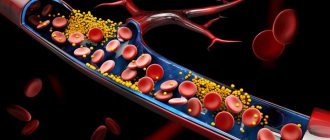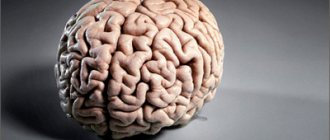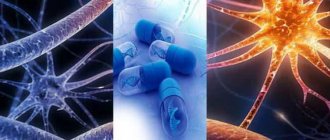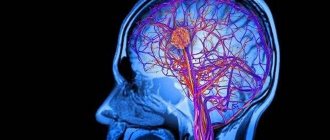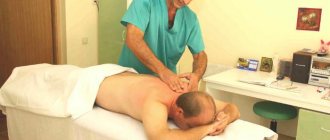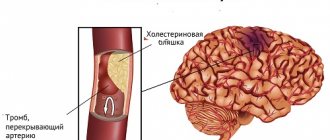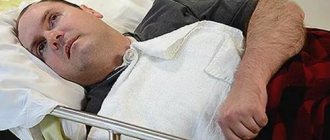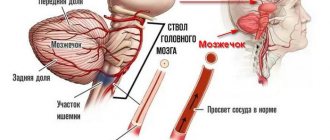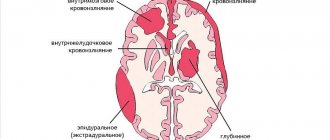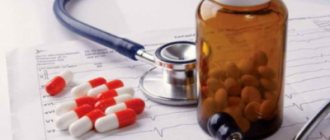From this article you will learn: what the consequences of a cerebral stroke in the right hemisphere can be, how severely the condition of patients is affected, and what it depends on. How long do people who have had a stroke on the right side live?
Author of the article: Nivelichuk Taras, head of the department of anesthesiology and intensive care, work experience 8 years. Higher education in the specialty “General Medicine”.
Article publication date: 01/13/2017
Article updated date: 07/15/2020
Stroke is included in the group of serious diseases. Every year thousands of people around the world die from it and become disabled. In general, 50–60% of patients manage to survive, and no more than 10% recover completely. This means that the consequences of the disease are really severe, and it is not always possible to influence them.
Click on photo to enlarge
The prognosis depends on several factors, which are described in the table:
| What are the consequences? | How factors influence the outcome |
| Form of the disease | The consequences of ischemic stroke are less dangerous than hemorrhagic stroke |
| Stroke dimensions | The larger the area of necrosis in the brain (massive stroke, or microstroke), the worse the prognosis for recovery |
| Involvement of vital brain centers in the process | Localization of a stroke in the brain stem is fatal |
| Age and general condition of the patient | The prognosis is worse for the elderly and people with severe underlying medical conditions |
| Time to provide assistance | The later the patient is brought to the hospital (more than 3–6 hours), the worse the consequences |
As for life expectancy after a stroke in the right hemisphere, it is in a wide range, as it depends on the factors described in the table, and ranges from several hours to tens of years.
A stroke on the right side of the brain differs in symptoms and consequences from the left side. This is due to the fact that each hemisphere is responsible for different brain functions.
Click on photo to enlarge
Characteristics of right-sided stroke
The left and right hemispheres of the brain are responsible for different functions, so the symptoms of a right-sided and left-sided stroke are different. Also, their nature depends on the form in which acute circulatory disorders occur in this organ. There are hemorrhagic and ischemic strokes. The first develops as a result of rupture of a blood vessel and subsequent hemorrhage, the second - when a blood clot forms that clogs the artery.
Rehabilitation doctor Sergei Nikolaevich Agapkin examines the ischemic and hemorrhagic form of the disease:
A right-sided stroke is dangerous because it is not always possible to diagnose it on time, since there are no characteristic manifestations of the pathology. This is due to the fact that in the area of the right hemisphere there are centers of sensitivity on the left side of the body and orientation in space, violations of which are quite difficult to notice.
The right side of the brain, in addition to those already mentioned, performs the following functions:
- Control of movements of the left side of the body;
- Color perception;
- Location perception;
- Development and control of emotions;
- Perception of the object as a whole;
- Ability to process large amounts of information.
When the right hemisphere is damaged, the patient's motor activity on the left side of the body, auditory and visual functions are impaired, there is a loss of sensitivity to pain, temperature changes, and apathy develops.
The most dangerous is a hemorrhagic stroke of the brain on the right side, since with hemorrhage, intracranial pressure increases significantly, and this leads to compression of the blood vessels and secondary ischemia . Under such conditions, the pathological process becomes generalized.
Read more about the symptoms and treatment of a major stroke.
Right-sided ischemic stroke is much more common. It is also called “cerebral infarction” (Read the detailed article about the difference between a stroke and a heart attack). In this case, the prognosis is less favorable than with damage to the left hemisphere, since the cells of the latter have a better ability to survive. During the acute period (the first three weeks), a third of the patients die from the disorders that occur.
Emergency assistance in case of cerebrovascular accident should be provided within the first three hours. In the absence of alarming symptoms, this most often cannot be done. Delay is fraught with serious complications and death.
What is this?
If we talk about ischemic stroke, it is an acute insufficiency of blood supply to the brain, which leads to a violation of the most important neurological functions. Its common causes are blockage of blood vessels by blood clots or emboli. Due to lack of blood supply, entire areas of the brain die. Accordingly, the functions for which they were responsible are disrupted.
In addition to ischemic stroke, hemorrhagic and subarachnoid strokes are distinguished. But in medical practice, cases of stroke of the ischemic type predominate (70-85%), when blockage or compression of blood vessels occurs as a result of embolism, thrombosis or other cardiovascular diseases.
With a hemorrhagic stroke, there is not compression, but rupture of blood vessels, followed by hemorrhage into the brain, blood entering its ventricles, under the membranes. Such a stroke is diagnosed in 20-25% of patients.
The rarest type is subarachnoid (1-7%). This stroke is traumatic in nature. It is a consequence of a ruptured arterial aneurysm or some kind of traumatic brain injury. There is an outpouring of blood into the space between the soft and arachnoid membranes of the brain.
A stroke is generally called an attack in which a focal or cerebral neurological deficit lasts more than a day. That is, during this time the blood supply to brain cells is acutely impaired. Those conditions in which neurological functions are restored after no more than three weeks are called a small stroke.
The consequences of a stroke in women depend on the period during which parts of the brain lacked blood, and with it oxygen and other elements necessary for cells.
Causes and symptoms
Right-sided stroke , like left-sided stroke, occurs under the influence of the following unfavorable factors:
- Having excess weight;
- Increased cholesterol levels in the blood;
- Smoking and drinking alcohol;
- Cervical osteochondrosis;
- High blood pressure;
- Taking hormonal contraceptives;
- Heart diseases;
- Migraine;
- Vascular atherosclerosis;
- Blood diseases;
- Stressful conditions, depression;
- Increased physical activity;
- Physical inactivity.
All of these reasons contribute to the development of stroke. If the pathology affects the right hemisphere, then the patient loses the ability to perform natural functions such as walking, speaking, and controlling the body. Recovery takes a long time.
Pathology of the blood vessels of the right hemisphere of the brain can develop not only in the elderly , but also in adolescents and even children. In this case, risk factors include congenital defects of the heart muscle, dysfunction of the endocrine system, and hereditary blood diseases.
A stroke on the right side of the brain is characterized by the following manifestations:
- Paralysis of the left side of the body;
- Severe headaches. If a hemorrhagic stroke develops, the sensations are compared to being hit by a dagger, and the person may scream in pain and even lose consciousness;
- Epilepsy attacks;
- The patient is unable to lie on his back or tilt his head to the side;
- Impaired consciousness;
Read the article telling us what chronic cerebral ischemia is - what causes it, how it appears and why it is dangerous.
Neurologist Mikhail Moiseevich Shperling will talk about the symptoms of the pathology:
- Vomiting, nausea;
- A sharp decrease in vision;
- Speech disorders. This manifestation is typical for left-handers, since their center responsible for speech is located in the right hemisphere. In right-handed people, the corresponding center is located in the left part of the brain;
- Memory loss, and a person cannot remember what happened to him very recently, but retains information about what happened in the distant past;
- Asymmetry of features on one side of the face (one corner of the mouth droops, the nasolabial fold on the right side is smoothed out);
- Impaired ability to swallow.
If extensive ischemic stroke develops , characteristic symptoms appear rapidly. In this case, the nerve cells die literally within a few minutes.
Consequences that aggravate the patient's condition
The consequences of a stroke in women (left-sided, right-sided) can be aggravated by additional factors:
- The main focus of brain damage is in its functionally significant areas. In particular, in the speech and motor centers.
- The extent of the brain lesion.
- The advanced age of the patient is the main difficulty in restoring motor skills.
- Gross violation of muscle tone of the limbs.
- Violation of muscle-joint sensation (the patient does not feel where his limb is if he does not see it).
- Decrease in intelligence level.
- Emotional consequences (particularly depression).
Consequences of stroke, prognosis
Ischemic stroke of the right hemisphere, if assistance is not provided in a timely manner, in most cases leads to serious consequences, including:
- Weakening of the ability to think;
- Development of epilepsy;
- Absent-mindedness;
- Complete or partial paralysis of the left side of the body;
- Inability to self-care;
- Loss of sensation;
- Loss of ability to speak and write;
- Memory loss;
- Brain swelling;
- Muscle weakness;
- A comatose state in which the patient may remain for an indefinite period of time - either for a week or for several years;
- Depression, indifference to everything.
After an ischemic stroke, the prognosis is more favorable than after a circulatory disorder in the vessels of the brain caused by hemorrhage. About 75% of patients remain alive, half of whom, provided proper treatment, have a chance of overcoming the consequences of acute cerebrovascular accident.
With a second stroke, the likelihood of survival decreases several times.
Answering the question of how long people who have had a stroke live, experts indicate that this disease reduces life expectancy by 4-6 years. It is impossible to give an accurate prognosis, since the consequences of an ischemic stroke on the right side of the brain at any time can lead to the re-development of pathology and death.
The most common cause of death is complications such as pneumonia, kidney failure, and cerebral edema. If help was not provided in a timely manner, 70% of victims of right-sided stroke live no more than a year.
Those who fall into a coma as a result of vascular pathology have minimal chances of survival.
Since acute cerebrovascular accident has a destructive effect on the central nervous system, more than half of the victims become disabled.
Various long-term consequences in seriously ill patients
People who have fully recovered from a stroke on the right side, or who are disabled but not bedridden, can live for decades. All bedridden patients are susceptible to secondary consequences, which cause severe complications or death. It can be:
- Contracture of the joints of the left arm and leg - after a few years they freeze in a bent position and cannot be straightened, even with great effort.
- Infectious processes of the lungs - impaired swallowing, gastric tube and poor breathing contribute to the accumulation of mucus in the respiratory tract. The infection multiplies in them, which causes the development of pneumonia (pneumonia).
- Kidney infection - difficulty urinating and a catheter installed in the bladder creates conditions for inflammation in the kidneys.
- Bedsores are the formation of large non-healing wounds on the buttocks, in the area of the cross and hip joints.
- General exhaustion of the body, swelling.
Any stroke is a pathological process that follows an individual scenario. Yes, it has the most common patterns and outcomes. But nothing gives you the right to give up and not do everything possible to ensure that its consequences are as small as possible. Remember - everything is in your hands!
Treatment approaches
A patient with signs of a left-sided or right-sided stroke should be taken to a medical facility as soon as possible. Before the ambulance arrives, you need to place a pillow or any other soft object under the patient’s head, and open all the windows in the room to allow fresh air to enter. You also need to unfasten the top buttons on the victim’s clothes, loosen the tie, and remove the scarf. It is necessary to ensure that the head is not thrown back and is at the same level as the body line. In no case should you try to bring the patient to consciousness with the help of ammonia, especially if convulsions are observed.
Table 1. Stroke treatment methods
| Treatment method | Main directions |
| Use of medications | · Intravenous administration of drugs that dissolve a blood clot that has blocked a vessel; · Use of drugs to stabilize blood pressure; · Using blood thinners to prevent the re-formation of a blood clot; · Taking antioxidant drugs. |
| Surgery (usually performed for hemorrhage) | Carrying out surgery to remove blood clots and plaques that impede normal blood circulation in the vessels of the brain. |
| Physiotherapeutic treatment (indicated during the rehabilitation period) | Application of the following procedures: · Magnetotherapy; · Laser therapy; · Acupuncture; · Use of therapeutic mud for deep muscle warming; · Electrophoresis with the introduction of magnesium sulfate, papaverine, potassium bromide. |
| Massage | Massage for stroke begins from the first days. |
| Physiotherapy | Special exercises are performed 4-6 times a day. They use various equipment - balls, light boxes. It is prohibited to use an expander. First, gymnastics is performed from a lying position, then sitting. Getting back on your feet is allowed only after an adaptation period. |
During the rehabilitation period, it is permissible to use traditional medicine. So, for stroke in men and women, the following are useful:
- Alcohol tincture based on pine cones with the addition of natural apple cider vinegar;
- Lemons minced with garlic and sugar;
Dear readers, familiarize yourself with the methods of treatment using traditional medicine. One of them is to use pine cones:
- Decoctions of calendula, plantain, St. John's wort;
- Honey with the addition of wormwood.
During the recovery period, the patient should feel the support and care of loved ones. He needs to provide a social circle and organize regular walks in the fresh air. All this will help overcome apathy and depression, which often follow a stroke.
Rehabilitation
The recovery period begins approximately a week after intensive therapy, it is developed by doctors of different specialties: rehabilitation specialists, neurologists, psychologists, physiotherapists, speech therapists, reflexologists, occupational therapists (specialists in the restoration of social, everyday, functional, motor skills), neurodefectologists.
There is a whole playlist on Youtube on this topic https://www.youtube.com/playlist?list=PLb9qc1uRvT8oorWN7lanTWl2BVkTJGm3v
The first stage is inpatient, the second is sanatorium, but the full course is carried out at home, which can last for several years. The set of measures includes: medications, exercise therapy, acupuncture, reflexology, physiotherapy, kinesiotherapy (exercise therapy based on oriental practices), massage, diet. The treatment regimen is strictly individual.
At home you need:
- eliminate all physical and psycho-emotional stress;
- balance the drinking and food diet with limiting lipoproteins;
- master a course of exercise therapy, including breathing;
- Constantly massage, especially in areas that have lost sensitivity;
- sanitize chronic foci of infection, somatic pathologies;
- eliminate all bad habits.
Particular attention to the prevention of bedsores, purulent corneal ulcers, hypostatic pneumonia, and contractures. To do this, special exercises are performed, the upper respiratory tract is cleaned, and if necessary, parenteral nutrition and bladder catheterization are provided.
The duration of rehabilitation can be only a month (for a mild form) or up to two or more years (for a severe form). Average rehabilitation is six months.
How to prevent right-sided stroke?
To reduce the risk of developing a dangerous pathology, it is recommended:
- To refuse from bad habits;
- Control blood pressure and cholesterol levels in the blood;
- Lead an active lifestyle, engage in feasible physical exercise;
- Organize nutrition in such a way that the diet meets the principles of naturalness and health;
- Visit your doctor regularly and take all necessary measures to prevent the formation of blood clots;
- Take an ECG twice a year if there are heart rhythm disturbances.
Right-sided stroke is a dangerous condition that can lead to coma and death. Timely treatment gives the patient a chance to survive and even overcome the consequences of vascular pathology. Following preventive measures can reduce the risk of stroke.
First aid
Let us repeat once again that the consequences of a stroke in an elderly woman can be very serious - even death. Therefore, self-medication in this case is dangerous for the life and health of the patient.
If the test gives you reason to think that the person is having a stroke, call an ambulance as quickly as possible. Before specialists arrive, you can help the victim with the following:
- If the person is lying down, raise his head a little.
- Loosen the clothes that are restricting his body and breathing.
- Measure your blood pressure.
- Suggest a medicine that normalizes blood pressure. But only from those medications that the patient had previously taken.
- Place the patient's feet in a basin of moderately hot water.
- Turn the victim onto his right side. If a person feels the urge to vomit, place a tray under his mouth.
- If the patient loses consciousness, take out his tongue and press it so that it does not sink in.
Diagnostics
Confirmation of the diagnosis of hemorrhagic or ischemic stroke of the right hemisphere of the brain is based on magnetic resonance imaging of the brain.
This diagnostic technique makes it possible to identify an ischemic stroke on the right side, the reliable location of the pathological focus, its size and extent of prevalence.
How to recover
After a stroke that paralyzes the right side, recovery is easier. When the left one is hit, everything becomes more complicated. However, recovery time is always individual. And the principles of rehabilitation will be the same in both cases.
Your doctor will tell you how to recover after a stroke. It should be remembered that early initiation of rehabilitation gives good results and increases the chances of full recovery.
The doctor prescribes further drug treatment and rehabilitation methods. But a lot depends on the patient’s condition. His limbs may become paralyzed, and then techniques such as passive gymnastics and massage are first used.
When they give results, you can move on to active exercises. Over time, this will be a whole complex of physical therapy. Some of the exercises will even be performed on simulators. The rehabilitation program also includes various physiotherapeutic procedures.
However, rehabilitation requires an integrated approach. In addition to purely physiological methods of restoring the sensitivity of the affected parts, correction is also needed in the psycho-emotional sphere. This often requires the help of a neuropsychologist. In left-handed people with a right-sided stroke, the speech center may be affected; they will need classes with a speech therapist.
Important information: What kind of surgery is done after a cerebral stroke?
Drug therapy
For drug therapy in the recovery period, nootropic drugs are more often used. They improve the higher integrative functions of the brain and help strengthen the nervous system, making it more resistant to damaging factors.
There are different groups of such drugs, they differ in their mechanism of action - for example, pyridoxine derivatives enhance cerebral cholinergic conductivity, other drugs accelerate the penetration of glucose through the blood-brain barrier into brain cells and improve its utilization.
For example, Piracetam improves memory and facilitates the rehabilitation process after a stroke. Can be taken in long courses. It is especially indicated for elderly patients.
Among the nootropics, Picamilon can also be distinguished, the action of which is based on the properties of nicotinic acid and GABA. The first plays an important role in the processes of tissue respiration. The drug is especially useful in cases of dysfunction of the optic nerve.
Phenibut and Pantogam have, in addition to nootropic, psychostimulating effects. They are recommended for people after a stroke, suffering from neurosis-like conditions and sleep disorders.
Lifestyle
A right-sided ischemic stroke often means that the patient has to learn to live again.
Family members should not do anything for the patient, only help him. It is necessary to arrange handrails in the house for movement, to fix some objects, but the patient must learn gradually, avoiding pain and fatigue, to take care of himself and even perform minor work.
You need to lie down less and sit more. When working with your hands, it is recommended to find solid support. Start exercises only from the stronger side, slowly, so that you are aware of the movements and without holding your breath, so that the pressure does not increase.
It's worth finding a hobby that involves your hands. This can be embroidery, knitting, drawing, modeling (ships, cars), spinning a yo-yo and a spinner. Hobbies return fine motor skills faster.
A special diet that limits fats is also needed. You will have to give up bad habits.
Folk recipes
Right-sided stroke cannot be treated with traditional methods. During the rehabilitation period, some of these remedies can be used, but only as additional therapy after consultation with a doctor.
Important information: What is the difference between a cerebral stroke and a heart attack and what are the first signs in women (men)
For example, you can make a drink based on pine decoction (1 tablespoon of raw material per glass of boiling water) and finely chopped lemon. Half of the fruit must first be peeled, then mixed with the prepared decoction. This product is considered an antioxidant that improves blood circulation. It is given twice a day, an hour before meals, half a glass.
Among the non-traditional methods, one can highlight hirudotherapy - treatment with medicinal leeches, which is especially useful in the ischemic form, since these parasites secrete an enzyme that resolves blood clots.
Right side massage
A right-sided ischemic stroke often leaves the patient paralyzed in the left limbs, the corresponding side of the face, or the left half of the body. In this case, a special therapeutic massage is indicated, which will restore metabolism in the affected area. In addition, the procedure stimulates the development of connections between the remaining living neurons of the brain, so that they can take on the functions of the dead.
But recovery after a stroke involves massage not only for the purposes described above. If a person lies in bed for a long time, then his tissues not only atrophy, but bedsores appear. This can be prevented with proper care, but mechanical action (i.e. massage) will also be needed to improve local blood flow and tissue trophism.
For therapeutic massage, classical techniques are used - stroking, kneading, rubbing (they help remove stagnation), as well as vibration.
